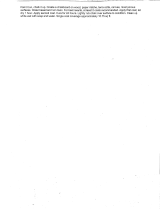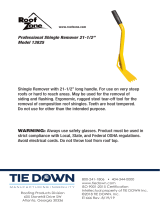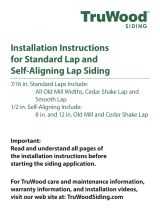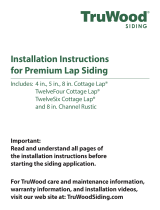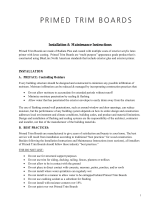Page is loading ...

GENERAL REQUIREMENTS:
• HardieShingle panels can be installed over braced wood or steel studs, 20 gauge (33 mils) minimum to 16 gauge (54 mils) maximum, spaced a maximum
of 24 in o.c. or directly to minimum 7/16 in thick OSB sheathing. See General Fastening Requirements. Irregularities in framing and sheathing can mirror
through the finished application. Correct irregularities before installing siding.
• Information on installing James Hardie products over non-nailable substrates such as gypsum, foam, etc. can be located in JH Tech Bulletin 19 at
www. jamehardie.com
• A water-resistive barrier is required in accordance with local building code requirements. The water-resistive barrier must be appropriately installed with
penetration and junction flashing in accordance with local building code requirements. James Hardie will assume no responsibility for water infiltration.
James Hardie does manufacture HardieWrap
®
Weather Barrier, a non-woven non-perforated housewrap¹, which complies with building code requirements.
• When installing James Hardie
®
products all clearance details in figs. 1 thru 14 must be followed.
• Adjacent finished grade must slope away from the building in accordance with local building codes - typically a minimum of 6in in the first 10ft.
• Do not install James Hardie products, such that they may remain in contact with standing water.
• HardieShingle panels may be installed on vertical wall applications only.
• DO NOT use stain, oil/alkyd base paint, or powder coating on James Hardie
®
Products.
• James Hardie Building Products provides installation/wind load information for buildings with a maximum mean roof height of 85 feet. For information on
installations above 60 feet, please contact JH technical support.
¹For additional information on HardieWrap® Weather Barrier, consult James Hardie at 1-866-4Hardie or www.hardiewrap.com
IMPORTANT: FAILURE TO FOLLOW JAMES HARDIE WRITTEN INSTALLATION INSTRUCTIONS AND COMPLY WITH APPLICABLE BUILDING CODES MAY VIOLATE LOCAL LAWS, AFFECT
BUILDING ENVELOPE PERFORMANCE AND MAY AFFECT WARRANTY COVERAGE. FAILURE TO COMPLY WITH ALL HEALTH AND SAFETY REGULATIONS WHEN CUTTING AND INSTALLING
THIS PRODUCT MAY RESULT IN PERSONAL INJURY. BEFORE INSTALLATION, CONFIRM YOU ARE USING THE CORRECT HARDIEZONE® PRODUCT INSTRUCTIONS BY VISITING
HARDIEZONE.COM OR CALL 1-866-942-7343 (866-9-HARDIE)
Visit jameshardiepros.com for the most recent version.
EFFECTIVE DECEMBER 2019
STAGGERED EDGE PANEL | STRAIGHT EDGE PANEL | INDIVIDUAL SHINGLES | HALF-ROUNDS PANELS
HardieShingle
®
Siding
SINGLE FAMILY INSTALLATION REQUIREMENTS
HS11121 P1/8 12/19
Store flat and keep dry and covered prior to
installation. Installing siding wet or saturated may
result in shrinkage at butt joints. Carry planks on
edge. Protect edges and corners from breakage.
James Hardie is not responsible for damage caused
by improper storage and
handling of the
product.
OUTDOORS
1. Position cutting station so that airflow blows dust away from the
user and others near the cutting area.
2. Cut using one of the following methods:
a. Best: Circular saw equipped with a HardieBlade
®
saw blade
and attached vacuum dust collection system. Shears
(manual, pneumatic or electric) may also be used, not
recommended for products thicker than 7/16 in.
b. Better: Circular saw equipped with a dust collection feature
(e.g. Roan
®
saw) and a HardieBlade saw blade.
c. Good: Circular saw equipped with a HardieBlade saw blade.
INDOORS
DO NOT grind or cut with a power saw indoors. Cut using shears (manual, pneumatic or
electric) or the score and snap method, not recommended for products thicker than 7/16 in.
- DO NOT dry sweep dust; use wet dust suppression or vacuum to collect dust.
- For maximum dust reduction, James Hardie recommends using the “Best” cutting
practices. Always follow the equipment manufacturer’s instructions for proper operation.
- For best performance when cutting with a circular saw, James Hardie recommends
using HardieBlade
®
saw blades.
- Go to jameshardiepros.com for additional cutting and dust control recommendations.
CUTTING INSTRUCTIONS
STORAGE & HANDLING:
IMPORTANT: The Occupational Safety and Health Administration (OSHA) regulates workplace exposure to silica dust. For construction sites, OSHA has deemed
that cutting fiber cement with a circular saw having a blade diameter less than 8 inches and connected to a commercially available dust collection system per
manufacturer’s instructions results in exposures below the OSHA Permissible Exposure Limit (PEL) for respirable crystalline silica, without the need for additional
respiratory protection.
If you are unsure about how to comply with OSHA silica dust regulations, consult a qualified industrial hygienist or safety professional, or contact your James
Hardie technical sales representative for assistance. James Hardie makes no representation or warranty that adopting a particular cutting practice will assure
your compliance with OSHA rules or other applicable laws and safety requirements.

Min. 1 in
Figure 1
Roof to Wall
Figure 2
Horizontal Flashing
Figure 4
Slabs, Paths, Steps to Siding
Figure 3
Kickout Flashing
CLEARANCE AND FLASHING REQUIREMENTS
Min. ¼ in
Min. 1 in
As required
by IRC code
min 4 in. x 4 in.
Figure 15C
TRIM CONSIDERATION:
Minimum 1 in trim thickness is needed as Panels
stack at a depth of roughly 15/16 in for the 7 in
reveal. If additional trim depth is desired, you can
place a spacer under the trim (Fig. 15C & 15D).
DO NOT install trim over HardieShingle.
Figure 15D
Figure 15BFigure 15A
HardieShingle
®
Siding
HS11121 P2/8 12/19
Min. ½ in
Min. ¼ in
Min. 6 in
Min. 1 in
Figure 7
Deck to Wall
Figure 8
Ground to Siding
Figure 10
Sheltered Areas
Figure 9
Gutter to Siding
Figure 12
Drip Edge
Figure 13
Block Penetration
Figure 14
Valley/Shingle Extension
Figure 11
Mortar/Masonry
Extend shingles
at least 1 in.
out from the
fascia when
gutters are
present
Min.
1 in.
Z-Flashing
Z-Flashing
Min. ¼ in.
Z-Flashing
L-Flashing
Min. ¼ in.
Do not caulk
(recommended for HZ10)

HardieShingle
®
Siding
HS11121 P3/8 12/19
GABLE INSTALLATION:
Figure 16
Figure 17
Figure 18
Figure 20 Figure 21
Figure 19
Installation over sheathing is recommended (Required for Individuals) for gables.*
1) Find the center stud of your of your Gable and snap a caulk line down
2) Measure out 16 in* to both the left and the right of the center line and snap a caulk line
3) Measure up 2 in if you are off a roof line or ¼ in if you are starting above a band board
4) Set the bottom of your 1 ¼ in starter strip at that line
5) Place your 8 ¼ in Starter Course -bottom level with the bottom of the starter strip
6) Set your first row of Shingle - starting the first piece at the vertical line left of center
(If you are using staggered edged shingles Trim down the first row to the shortest shingle length)
7) Drive nails approximately ¼ in above Key ways 5 per full panel Center Nail can be either one of the keyways.
(Stay by keyway to avoid shiners) (EX1) Blue Dots show nail placement
8) Measure up 7 in with straight and 6 in with Staggered edge and snap a caulk line to get your proper exposure
9) The second row will start at the center line
10) The Third row will start at the line right of center
11) As you work your way up the gable make sure you Keep your Cut Pieces you will use the pieces on the edges of the gable (EX2)
12) Edges Gable butting into trim leave a 1/8 in Gap (for house movement and Caulking)
13) Make sure to sure siding nails on the small pieces on the edges (Do not use a trim nail to install!)
*Panels can also be installed direct to stud up to 24 in OC.
Note: Snapped chalk lines help guide installation, when installing straight edge panels or Individual shingles use a straight edge on bottom edges if uniform straight edge is desired.
Find center of gable;
Snap a chalk line
1¼ in starter strip -
Make sure to meet
clearances at roof line
and/or horizontal trim
First shingle goes on
far left chalk line
Second row begins at
center chalk line
Use left over and new
pieces, where necessary,
to fill in opposite side
Third row begins at
right chalk line
Snap chalk line 7 in
above first row for
second row of shingles
Snap chalk line 7 in
above second row for
third row of shingles
Snap chalk line
15¼ in from
bottom of starter
course
8¼ in starter course
in line with starter
strip
15.25
7.00
Snap chalk line; 16 in from
center to the left and right
Min. 2 in

Note: For aesthetic purposes you may trim
the bottom of the panel to create a straight
edge. If doing so, ensure all cuts ends are
properly sealed and painted (fig 23)
HardieShingle
®
Siding
HS11121 P4/8 12/19
Panels for sidewall applications are available in 48 in lengths. Pieces needed for one square (100sq.ft.) of product coverage = approximately 43, based on maximum 7 in exposure.
HARDIESHINGLE STRAIGHT EDGE PANEL COVERAGE
7 IN EXPOSURE HARDIESHINGLE STRAIGHT EDGE PANELS INSTALLATION
(For 5 in exposure product please go to page 7)
Maximum Exposure of 7 in
Steps 1 - 4
REFER TO STAGGERED EDGE INSTRUCTIONS ABOVE
Figure 24
Steps 5 & 6
second
course
8¼ in
HardiePlank
®
lap
siding
trim first panel
to hit center of
furthest stud
1¼ in
starter
strip
15-1/4"
panels
sheathing
water-resistive
barrier
Trim 1/8 in min.
gap for
caulk
DO NOT NAIL THROUGH
THIS AREA
16 in or 24 in
o.c.
3/8 in
7 in
position nails on nail line and secure into framing. Only when application is to minimum 7/16 in thick APA rated
sheathing, position nails on nail line spaced a maximum of 13 3/4 in o.c. Allow 3/8 in from panel edges.
15-1/4 in
panels
1/8 in min.
gap for
caulk
7 in
7 in
first
course
second
course
third
course
Fastener Requirements
0.083 in x 0.187 in HD x 1 1/2 in long ringshank nails are used for fastening
HardieShingle
®
Staggered Edge Panels to both framing and to 7/16 in thick APA
rated sheathing.
HARDIESHINGLE STAGGERED EDGE PANELS INSTALLATION
Steps 1- 4
Steps 5 & 6
Panels for sidewall applications are available in 48 in lengths. Pieces needed for one square (100sq.ft.) of product coverage = approximately 50, based on a
maximum 6 in exposure from the top edge of HardieShingle panels in subsequent courses (refer to Figure 13).
HARDIESHINGLE STAGGERED EDGE PANEL COVERAGE
1/4 in gap. Do not caulk.
band board
Figure 23
Figure 22
HardieShingle
®
Staggered Edge Panel Installation
Install HardieShingle
®
panels with joints butted in moderate contact. Due to
overlapping of the joints, caulk is not required except where panels abut trim
boards. (fig. 22 & 24). Ensure keyways do not line up on subsequent courses.
1) Install a 1-1/4 in starter strip, then install a 8-1/4 in wide
HardiePlank
®
lap siding starter course.
2) Place first panel so that panel end centers over stud. Trim panel as
needed. Butt the cut end into trim as shown (figs 22 & 24). When
installing over a band board or any horizontal surface, leave
1/4 in gap between bottom of siding and flashing.
3) Secure panel, leaving 1/8 in gap for caulk at trim and continue the course
along the wall.
4) Start the second course, by removing the equivalent of one full stud
cavity (16 in or 24 in OC), again abutting the cut end into the trim (figs 22 & 24).
This is to prevent pattern repetition. Repeat step 3.
5) Start the third course, by removing the equivalent of two full stud
cavities (figs 22 & 24) and repeat step 3.
6) Continue up the wall repeating steps 2 through 6 until desired height is reached.
second
course
8 1/4 in
HardiePlank
®
lap
siding
trim first panel
to hit center of
furthest stud
1¼ in
starter
strip
15 7/8 in
panels
sheathing
water-resistive
barrier
Trim
1/8 in min.
gap for
caulk
DO NOT NAIL THROUGH
THIS AREA
16 in or 24 in
o.c.
3/8 in
6 in
position nails on nail line and secure into framing. Only when
application is to minimum 7/16 in thick APA rated sheathing,
position nails on nail line spaced a maximum of 13 3/4 in o.c.
Allow 3/8 in from panel edges.
6 in
6 in
second
course
third
course
first
course
1/8 in min. gap for caulk

HardieShingle
®
Siding
HS11121 P5/8 12/19
HARDIESHINGLE
HALF-ROUND PANELS INSTALLATION
Fastener Requirements
0.083 in x 0.187 in HD x 1 1/2 in long ringshank nails are used for
fastening HardieShingle Half-Round Panels to both framing and to 7/16 in
thick APA rated sheathing.
correct alignment
Figure 27
HARDIESHINGLE HALF-ROUND PANEL COVERAGE
thr ough pr
position nails into framing
evious courses.
Only when application is to minimum
7/16 in thick APA rated sheathing,
position nails at 13 3/4 in o.c.
Allow 3/8 in from panel edges
8-1/4 in HardiePlank
lap siding
Panels for sidewall applications are available in 48 in lengths. Pieces needed for one square (100 sq. ft.) of product
coverage=43 pieces with 7 in exposure.
15 1/4 in
shingles
1/8 gap
for
caulk
trim board
16 in or 24 in
o.c.
water-resistive
barrier*
sheathing
1 1/4 in
starter strip
trim first panel
to hit furthest stud
7 in
1 in
3/8 in
HardieShingle Half-Round Panel Installation
Install HardieShingle panels with joints butted in moderate contact. Due to
overlapping of the joints, caulk is not required except where panels abutt trim
boards. (fig. 27). Ensure keyways do not line up on subsequent courses.
1) Install a 1-1/4 in starter strip, then install a 8-1/4 in wide HardiePlank lap
siding starter course.
2) Place first panel so that panel end centers over stud. Trim panel as needed.
Butt the cut end into trim as shown (figs 18). When installing over a band
board or any horizontal surface, leave 1/4 in gap between bottom of siding
and flashing.
HARDIESHINGLE
INDIVIDUAL SHINGLE INSTALLATION
HardieShingle Individual Shingles must be installed with the widest part of the shingle
placed downwards and directly to minimum 7/16 in thick sheathing.
Fastener Requirements
0.091 in x 0.221 in HD x 1 1/2 in or 0.121 in x 0.371 in HD x 1 1/4 in long corrosion
resistant siding nails are used for fixing HardieShingle siding to 7/16 in thick APA
rated sheathing.
HardieShingle Individual Shingle Installation
Due to overlapping of the joints, caulk is not required except where panels butt trim
boards. Space shingles a maximum 1/4 in apart and leave a minimum lap of 1 1/2 in
between successive courses (fig. 26).
1) Install 1 1/4 in starter strip and a 8 1/4 in wide HardiePlank siding starter course.
2) Install first shingle from the end abutting trim. Install widest part of
shingle placed downwards. (fig. 25).
3) Secure shingle, leaving a 1/8 in gap for caulk at trim and continue the
course along the wall.
4) Start the second course, leaving a minimum lap of 1 1/2 in between
successive courses, again from the end abutting the trim. Repeat step 3.
5) Continue up the wall repeating steps 2 through 5 until desired height
is reached.
Figure 25
HARDIESHINGLE INDIVIDUAL SHINGLE COVERAGE
Figure 26
Individual Shingles for sidewall applications are available in assorted widths
as listed below. Bundles needed for one square (100 sq. ft.) of product coverage:
Shingle
Width
4-3/16 in
5-1/2 in
6-3/4 in
7-1/4 in
10 in
Number
of Bundles
3
6
3
6
3
Pieces
per Bundle
15
15
15
15
15
15-1/4 in
shingle
sheathing
water-resistive
barrier
Trim 1/8 in min.
gap for
caulk
16 in or 24 in
o.c.
8¼ in HardiePlank
lap siding
postion nails on nail line a
minimum of 3/8 in from edges
1¼ in
starter
strip
7 in
15-1/4 in
shingle
7 in max.
exposure
space
shingles
max 1/4 in
apart
Leave a min. lap
of 1-1/2 in between
joints in succesive
course
Install with the widest part of
the shingle placed downwards
!
3) Secure panel, leaving 1/8 in gap for caulk at trim and continue the course along
the wall.
4) Start the second course, by removing the equivalent of one full stud cavity (16 in
or 24 in OC), again abutting the cut end into the trim (fig 27). This is to prevent
pattern repetition. Repeat step 3.
5) Start the third course, by removing the equivalent of two full stud cavities (figs
28 & 30) and repeat step 3.
6) Continue up the wall repeating steps 2 through 6 until desired height is reached.

HardieShingle
®
Siding
HS11121 P6/8 12/19
Figure 28
CORNER DETAILS
A. Panels butted against corner boards.
B. Panels butted against square wood
strip on inside corner, flashing behind.
C. Laced outside corner.
D. Laced inside corner.
minimum (1 in) thick trim
WINDOWS AND DOORS
Building wall components such as windows, doors and other exterior wall penetrations shall be installed in accordance with the component manufacturer’s written
installation instructions and local building codes. Where windows or doors are installed, continue the application of siding as if the wall is complete. Triming for the
opening and using the resulting piece may throw off the spacing above the break.
PNEUMATIC FASTENING
GENERAL FASTENING REQUIREMENTS
James Hardie products can be hand nailed or fastened with a
pneumatic tool. Pneumatic fastening is highly recommended.
Set air pressure so that the fastener is driven snug with the
surface of the siding. A flush mount attachment on the
pneumatic tool is recommended. This will help control the
depth the nail is driven. If setting the nail depth proves
difficult, choose a setting that under drives the nail. (Drive
under driven nails snug with a smooth faced hammer - Does
not apply for installation to steel framing).
Refer to the applicable ESR report online to determine which fastener meets your wind load design criteria
Fasteners must be corrosion resistant, galvanized, or stainless steel. Electro-galvanized are acceptable but may exhibit premature corrosion. James Hardie recommends the
use of quality, hot-dipped galvanized nails. James Hardie is not responsible for the corrosion resistance of fasteners. Stainless steel fasteners are recommended when
installing James Hardie
®
products near the ocean, large bodies of water, or in very humid climates.
Manufacturers of ACQ and CA preservative-treated wood recommend spacer materials or other physical barriers to prevent direct contact of ACQ or CA preservative-treated
wood and aluminum products. Fasteners used to attach HardieTrim Tabs to preservative-treated wood shall be of hot dipped zinc-coated galvanized steel or stainless steel
and in accordance to 2009 IRC R317.3 or 2009 IBC 2304.9.5
• Consult applicable product evaluation or listing for correct fasteners type and placement to achieve specified design wind loads.
• NOTE: Published wind loads may not be applicable to all areas where Local Building Codes have specific jurisdiction. Consult James Hardie Technical Services if you are
unsure of applicable compliance documentation.
• Drive fasteners perpendicular to siding and framing.
• Fastener heads should fit snug against siding (no air space).
• NOTE: Whenever a structural member is present, HardiePlank should be fastened with even spacing to the structural member. The tables allowing direct to OSB or plywood
should only be used when traditional framing is not available.
SNUG FLUSH
ALUMINUM
CLIPPED
STAPLES
HEAD NAILS
FASTENERS
UNDER
DRIVE
OVER
DRIVE
SLANT
IF, THEN IF, THEN ADDITIONAL NAIL
WOOD
FRAME
HAMMER
FLUSH
REMOVE &
REPLACE
COUNTERSINK
& FILL
STEEL
FRAME
FACE
NAIL
DO NOT DO NOT
DO NOT USE
AL

HardieShingle
®
Siding
Panels for sidewall applications are available in 48 in lengths. Pieces needed for one square (100sq.ft.) of product coverage =
approximately 60, based on maximum 5 in exposure.
HARDIESHINGLE
®
STRAIGHT EDGE PANEL COVERAGE
Maximum Exposure of 5 in
Steps 1 - 4
REFER TO STAGGERED EDGE INSTRUCTIONS ON PAGE 3
Figure 29
Steps 5 & 6
second
course
6¼ in HardiePlank
lap siding
trim first panel
to hit center of
furthest stud
1¼ in
starter
strip
14 in
panels
sheathing
water-resistive
barrier
Trim 1/8 in min.
gap for
caulk
DO NOT NAIL THROUGH
THIS AREA
16 in or 24 in
o.c.
3/8 in
5 in
position nails on nail line and secure into framing. Only when application
is to minimum 7/16 in thick APA rated sheathing, position nails on nail
line spaced a maximum of 13 3/4 in o.c. Allow 3/8 in from panel edges.
14 in
panels
1/8 in min.
gap for
caulk
5 in
5 in
first
course
second
course
third
course
PAINTING
CAULKING
For best results use an Elastomeric Joint Sealant complying with ASTM C920 Grade NS,
Class 25 or higher or a Latex Joint Sealant complying with ASTM C834. Caulking/Sealant
must be applied in accordance with the caulking/sealant manufacturer’s written instructions.
Note: some caulking manufacturers do not allow "tooling".
DO NOT use stain, oil/alkyd base paint, or powder coating on James Hardie
®
Products. Factory-primed James Hardie products must be painted within 180
days of installation. 100% acrylic topcoats are recommended. Do not paint
when wet. For application rates refer to paint manufacturers specifications.
Back-rolling is recommended if the siding is sprayed.
CUT EDGE TREATMENT
Caulk, paint or prime all field cut edges. James Hardie touch-up kits are required to
touch-up ColorPlus products.
PAINTING JAMES HARDIE
®
SIDING AND TRIM PRODUCTS WITH COLORPLUS
®
TECHNOLOGY
When repainting ColorPlus products, James Hardie recommends the following regarding surface preparation and topcoat application:
• Ensure the surface is clean, dry, and free of any dust, dirt, or mildew
• Repriming is normally not necessary
• 100% acrylic topcoats are recommended
• DO NOT use stain, oil/alkyd base paint, or powder coating on James Hardie
®
Products.
• Apply finish coat in accordance with paint manufacturers written instructions regarding coverage, application methods, and application temperature
• DO NOT caulk nail heads when using ColorPlus products, refer to the ColorPlus touch-up section
COLORPLUS
®
TECHNOLOGY CAULKING, TOUCH-UP & LAMINATE
• Care should be taken when handling and cutting James Hardie
®
ColorPlus
®
products. During installation use a wet soft cloth or soft brush to gently wipe off any
residue or construction dust left on the product, then rinse with a garden hose.
• Touch up nicks, scrapes and nail heads using the ColorPlus
®
Technology touch-up applicator. Touch-up should be used sparingly.
If large areas require touch-up, replace the damaged area with new HardiePlank
®
lap siding with ColorPlus
®
Technology.
• Laminate sheet must be removed immediately after installation of each course.
• Terminate non-factory cut edges into trim where possible, and caulk. Color matched caulks are available from your ColorPlus
®
product dealer.
• Treat all other non-factory cut edges using the ColorPlus Technology edge coaters, available from your ColorPlus product dealer.
Note: James Hardie does not warrant the usage of third party touch-up or paints used as touch-up on James Hardie ColorPlus products.
Problems with appearance or performance arising from use of third party touch-up paints or paints used as touch-up that are not James Hardie touch-up will not be covered
under the James Hardie ColorPlus Limited Finish Warranty.
HS11121 P7/8 12/19
HardieShingle
®
Siding
Panels for sidewall applications are available in 48 in lengths. Pieces needed for one square (100sq.ft.) of product coverage =
approximately 60, based on maximum 5 in exposure.
HARDIESHINGLE
®
STRAIGHT EDGE PANEL COVERAGE
5 IN EXPOSURE HARDIESHINGLE
®
STRAIGHT EDGE PANELS INSTALLATION (For 7 in exposure product please go to page 4)
Steps 1 - 4
DO NOT NAIL THROUGH
THIS AREA
3/8 in
5 in
5 in
5 in
first
course
second
course
third
course
PAINTING
CAULKING
CUT EDGE TREATMENT
Caulk, paint or prime all field cut edges. James Hardie touch-up kits are required to
touch-up ColorPlus products.
COLORPLUS
®
TECHNOLOGY CAULKING, TOUCH-UP & LAMINATE
• Care should be taken when handling and cutting James Hardie
®
ColorPlus
®
products. During installation use a wet soft cloth or soft brush to gently wipe off any
residue or construction dust left on the product, then rinse with a garden hose.
• Touch up nicks, scrapes and nail heads using the ColorPlus
®
Technology touch-up applicator. Touch-up should be used sparingly.
If large areas require touch-up, replace the damaged area with new HardiePlank
®
lap siding with ColorPlus
®
Technology.
• Laminate sheet must be removed immediately after installation of each course.
• Terminate non-factory cut edges into trim where possible, and caulk. Color matched caulks are available from your ColorPlus
®
product dealer.
• Treat all other non-factory cut edges using the ColorPlus Technology edge coaters, available from your ColorPlus product dealer.
Note: James Hardie does not warrant the usage of third party touch-up or paints used as touch-up on James Hardie ColorPlus products.
Problems with appearance or performance arising from use of third party touch-up paints or paints used as touch-up that are not James Hardie touch-up will not be covered
under the James Hardie ColorPlus Limited Finish Warranty.

HardieShingle
®
Siding
HARDIESHINGLE
®
INDIVIDUAL SHINGLE INSTALLATION
HardieShingle Individual Shingles must be installed with the widest part of the
shingle placed downwards and directly to minimum 7/16 in thick sheathing.
Fastener Requirements
0.091 in x 0.221 in HD x 1 1/2 in or 0.121 in x 0.371 in HD x 1 1/4 in long
corrosion resistant siding nails are used for fixing HardieShingle siding to 7/16
in thick APA rated sheathing.
HardieShingle Individual Shingle Installation
Due to overlapping of the joints, caulk is not required except where panels
butt trim boards. Space shingles a maximum 1/4 in apart and leave a min.
lap of 1 1/2 in between successive courses (fig. 31).
1) Install 1 1/4 in starter strip and a 6 1/4 in wide HardiePlank siding starter
course.
2) Install first shingle from the end abutting trim. Install widest part of shingle
placed downwards. (fig. 30).
3) Secure shingle, leaving a 1/8 in gap for caulk at trim and continue the
course along the wall.
4) Start the second course, leaving a minimum lap of 1 1/2 in between
successive courses, again from the end abutting the trim. Repeat step 3.
5) Continue up the wall repeating steps 2 through 5 until desired height is
reached.
Figure 30
5 IN EXPOSURE HARDIESHINGLE
®
INDIVIDUAL SHINGLE COVERAGE
Figure 31
Individual Shingles for sidewall applications are available in assorted widths
as listed below. Bundles needed for one square (100 sq. ft.) of product coverage:
Shingle
Width
3-1/2 in
4-1/2 in
5-1/2 in
7 in
8-3/4 in
Number
of Bundles
3
6
6
6
3
Pieces
per Bundle
20
20
20
20
20
14 in
shingle
sheathing
water-resistive
barrier
Trim 1/8 in min.
gap for
caulk
16 in or 24 in
o.c.
6¼ in
HardiePlank
®
lap
siding
postion nails on nail line a
minimum of 3/8 in from edges
1¼ in
starter
strip
5 in
14 in
shingle
5 in max.
exposure
space
shingles
max 1/4 in
apart
Leave a min. lap
of 1-1/4 in between
joints in succesive
course
Install with the widest part of
the shingle placed downwards
!
HS11121 P8/8 12/19
Product warranties, safety information and additional installation
information are available at jameshardiepros.com
© 2019 James Hardie Building Products, Inc. All rights reserved TM, SM and ®
denote trademarks or registered trademarks of James Hardie Technology Limited.
WARNING: This product can expose you to chemicals including respirable crystalline silica, which is known to the State of California to cause cancer. For more information go to P65Warnings.ca.gov.
RECOGNITION: In accordance with ICC-ES Evaluation Report ESR-2290, HardieShingle® lap siding is recognized as a suitable alternate to that specified in the 2006, 2009, 2012 & 2015 International Residential Code for One and Two-Family
Dwellings, and the 2006, 2009, 2012 & 2015 International Building Code. HardieShingle lap siding is also recognized for application in the following: City of Los Angeles Research Report No. 24862, State of Florida Product Approval FL#13192,
U.S. Dept. of HUD Materials Release 1263f, Texas Department of Insurance Product Evaluation EC-23. These documents should also be consulted for additional information concerning the suitability of this product for specific applications.
DANGER: May cause cancer if dust from product is inhaled. Causes damage to lungs and respiratory system through prolonged or repeated inhalation of dust from product. Refer to the current product Safety Data Sheet before use.
The hazard associated with fiber cement arises from crystalline silica present in the dust generated by activities such as cutting, machining, drilling, routing, sawing, crushing, or otherwise abrading fiber cement, and when cleaning
up, disposing of or moving the dust. When doing any of these activities in a manner that generates dust you must (1) comply with the OSHA standard for silica dust and/or other applicable law, (2) follow James Hardie cutting
instructions to reduce or limit the release of dust; (3) warn others in the area to avoid breathing the dust; (4) when using mechanical saw or high speed cutting tools, work outdoors and use dust collection equipment; and (5) if no
other dust controls are available, wear a dust mask or respirator that meets NIOSH requirements (e.g. N-95 dust mask). During clean-up, use a well maintained vacuum and filter appropriate for capturing fine (respirable) dust or use
wet clean-up methods - never dry sweep.
SILICA WARNING
/
